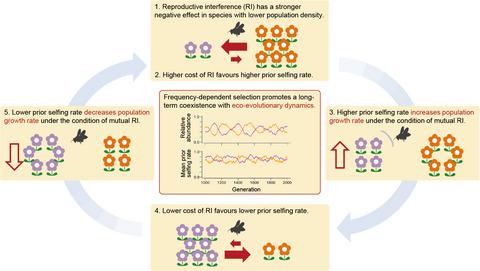Our official English website, www.x-mol.net, welcomes your
feedback! (Note: you will need to create a separate account there.)
The eco-evolutionary dynamics of prior selfing rates promote coexistence without niche partitioning under conditions of reproductive interference
Journal of Ecology ( IF 5.3 ) Pub Date : 2021-09-16 , DOI: 10.1111/1365-2745.13768 Koki R. Katsuhara 1 , Yuuya Tachiki 2 , Ryosuke Iritani 3 , Atushi Ushimaru 1
中文翻译:

先前自交率的生态进化动力学促进了在生殖干扰条件下没有生态位划分的共存
更新日期:2021-11-12
Journal of Ecology ( IF 5.3 ) Pub Date : 2021-09-16 , DOI: 10.1111/1365-2745.13768 Koki R. Katsuhara 1 , Yuuya Tachiki 2 , Ryosuke Iritani 3 , Atushi Ushimaru 1
Affiliation

|
- Pollinator-mediated reproductive interference can occur when two or more plant species share the same pollinators. Recent studies have suggested that prior autonomous selfing mitigates reproductive interference, potentially facilitating coexistence even in the absence of pollination niche partitioning (i.e. the pre-emptive selfing hypothesis). However, whether the evolution of prior selfing promotes coexistence, in the context of the eco-evolutionary dynamics of population size, selfing rates and inbreeding depression, remains poorly understood.
- We constructed an individual-based model to examine the conditions under which the evolution of prior selfing promotes coexistence in the context of mutual reproductive interference. In the model, two plant species compete by way of mutual reproductive interference, and both have the potential to evolve the capacity for prior autonomous selfing. We expected that purging of deleterious mutations might result in evolutionary rescue, assuming that the strength of inbreeding depression declines as the population selfing rate increases; this would enable inferior competitors to maintain population density through the evolution of prior selfing.
- Our simulation demonstrated that evolution of prior selfing may promote coexistence, whereas reproductive interference in the absence of such evolution results in competitive exclusion. We found that lower pollinator availability is likely to favour rapid evolutionary shifts to higher prior selfing rates, thereby neutralising the negative effects of reproductive interference in both species. When the strength of inbreeding depression decreased with an increase in the population-level selfing rate, moderate pollinator availability resulted in long-term coexistence in which relative abundance-dependent selection on the prior selfing rate served to intermittently maintain the population density of the inferior competitor.
- Synthesis. We demonstrate that the evolution of prior selfing may increase population growth rates of inferior competitors and may consequently promote long-term coexistence via an evolutionary rescue. This constitutes a novel mechanism explaining the co-evolutionary coexistence of closely related plant species without niche partitioning, and is consistent with recent studies reporting that closely related species with mixed mating systems can co-occur sympatrically, even under conditions of mutual reproductive interference.
中文翻译:

先前自交率的生态进化动力学促进了在生殖干扰条件下没有生态位划分的共存
- 当两个或多个植物物种共享相同的传粉媒介时,就会发生传粉媒介介导的生殖干扰。最近的研究表明,先前的自主自交减轻了生殖干扰,即使在没有授粉生态位分区(即先发制人的自交假说)的情况下也可能促进共存。然而,在种群规模、自交率和近交衰退的生态进化动态的背景下,先前自交的进化是否促进了共存,仍然知之甚少。
- 我们构建了一个基于个体的模型,以检查在相互生殖干扰的背景下,先前自交的进化促进共存的条件。在该模型中,两种植物物种通过相互繁殖干扰的方式进行竞争,并且都具有进化先验自主自交能力的潜力。我们预计清除有害突变可能会导致进化拯救,假设近交抑制的强度随着种群自交率的增加而下降;这将使劣等竞争者通过先前自交的进化来保持种群密度。
- 我们的模拟表明,先前自交的进化可能会促进共存,而在没有这种进化的情况下,生殖干扰会导致竞争排斥。我们发现较低的传粉媒介可用性可能有利于快速进化转变为更高的先前自交率,从而抵消两个物种生殖干扰的负面影响。当近交衰退的强度随着种群水平自交率的增加而降低时,适度的传粉媒介可用性导致长期共存,其中对先前自交率的相对丰度依赖性选择有助于间歇性地维持劣势竞争者的种群密度.
- 合成。我们证明先前自交的进化可能会增加劣势竞争者的人口增长率,并因此可能通过进化拯救促进长期共存。这构成了一种新机制,解释了没有生态位划分的密切相关植物物种的共同进化共存,并且与最近的研究报告一致,即具有混合交配系统的密切相关物种即使在相互生殖干扰的条件下也可以同域共存。









































 京公网安备 11010802027423号
京公网安备 11010802027423号